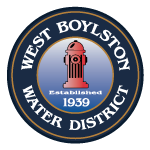The quality of water pumped and distributed by the West Boylston Water District meets or surpasses United States Environmental Protection Agency (EPA) and Massachusetts Department of Environmental Protection (MassDEP) primary drinking water guidelines and regulations. Both EPA and MassDEP require that the water be tested regularly.
Annual Drinking Water Quality Reports
Every year, in accordance with federal drinking water regulations, we issue a report on the quality of the water we provided over the past year. To view our reports, please visit our Reports page.
We treat the water in the District at each water source prior to distribution:
- We elevate the pH of the water by injecting potassium hydroxide, which helps to control corrosion.
- Iron and manganese tend to stain fixtures, so we add a polyphosphate blend to sequester these elements.
- We disinfect the water per Massachusetts Department of Environmental Protection standards with sodium hypochlorite. For more information, please review the Chlorine Questions and Answers document.
The EPA and MassDEP regulations limit the amount of certain contaminants in public water systems and we must test our water regularly to ensure that our tap water is safe to drink. A certified laboratory, which reports the results directly to MassDEP, performs all of our testing. Tests for bacterial contamination are performed monthly; tests for other contaminates are performed annually or at a frequency determined by MassDEP.
Coliform bacteria are naturally present in the environment and they are used as an indicator of other possible pathogens or problems with a drinking water distribution system. When coliforms are found in testing, we are required to conduct an assessment to identify any problems and, if necessary, take corrective actions.
The results of our water quality testing are contained in our Annual Drinking Water Quality Reports. Please check our Reports page for the latest results.
Drinking water, including bottled water, may reasonably be expected to contain at least small amounts of contaminants. This doesn’t necessarily post a health risk. However, some people may be more vulnerable to contaminants than the general population. See the EPA’s Ground Water and Drinking Water site for more information.
Sources of drinking water (both tap water and bottled water) include rivers, lakes, streams, ponds, reservoirs, springs, and wells. As water travels over the surface of the land or through the ground, it dissolves naturally-occurring minerals and, in some cases, radioactive material, and can pick up substances resulting from the presence of animals or from human activity.
Contaminants that may be present in source water include:
- Microbial contaminants - such as viruses and bacteria, which may come from sewage treatment plants, septic systems, agricultural livestock operations, and wildlife.
- Inorganic contaminants - such as salts and metals. These can be naturally occurring or result from stormwater runoff, wastewater discharges, or industrial, mining or farming activity.
- Pesticides and herbicides - from stormwater runoff, agricultural and residential uses.
- Organic chemical contaminants - by-products of industrial processes and petroleum production, gas stations, stormwater runoff and septic systems.
- Radioactive contaminants - which can be naturally occurring or result from oil and gas production and mining activities.
- Lead - If present, elevated levels of lead can cause serious health problems, especially for pregnant women and young children. Lead in drinking water is primarily from materials
and components associated with service lines and home plumbing. We are responsible for providing high quality drinking water, but cannot control the variety of materials used in plumbing components. When your water has been sitting for several hours, you can minimize the potential for lead exposure by flushing your tap for 30 seconds to 2 minutes before using water for drinking or cooking. If you are concerned about lead in your water, you should have your water tested. - Manganese - is a naturally occurring mineral found in ground and surface water. It is necessary for proper nutrition but can be dangerous for certain sensitive populations at elevated levels. Drinking water may naturally have manganese and when concentrations are high, the water may be discolored and taste bad. Children younger than one year old should not be given water with manganese concentrations over 300 parts per billion, nor should formula for infants be made with that water for more than a total of 10 days in a year.
The Oakdale Well and Pleasant Valley Well have elevated levels of Manganese in the water. This element that has been occurring naturally within the ground is one of the top priority concerns of the District. In January of 2023, the District put the Oakdale filter plant on line to remove manganese from the water coming from Oakdale well. We have been controlling the use Pleasant Valley well to reduce the amount of Manganese that is pumped into the water system. We sample monthly for Manganese at the wells, tanks and other areas of the distribution system. West Boylston Water District continues to work to supply the safest drinking water to the residents of West Boylston.
System Disruption
Occasionally, the water system experiences disruptions that may stir up mineral sediment from the bottom of the water mains that can make their way into your home. Generally, these are few and far between, and can be quickly pushed through with some aggressive flushing. These occurrences happen during and after water main breaks, at the beginning of the watering season when irrigation systems are turned on, during high-usage times (usually summer weekends), during fire flow testing, and hydrant flushing. If you see this in your home, they will mostly clear up in a matter of minutes by turning your cold water taps full force. We recommend using outside spigots if possible, and the cold water tap in your tub/shower. If there is still murkiness remaining after a good flushing, call us for assistance at 508-835-3025.
